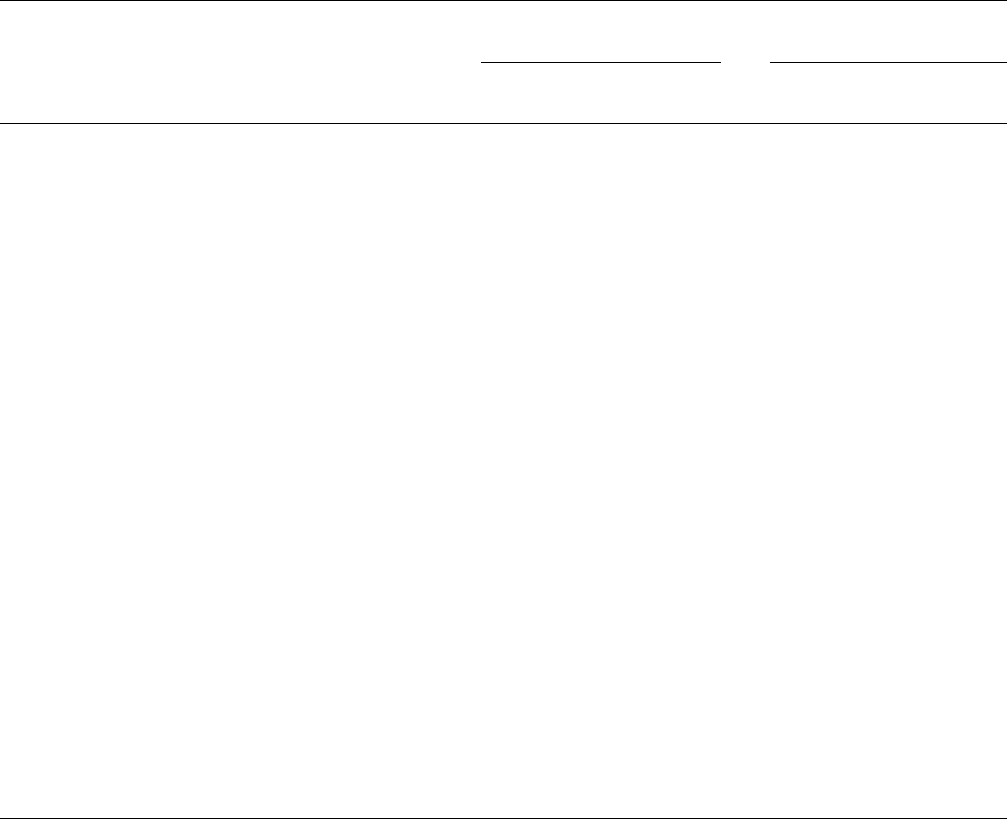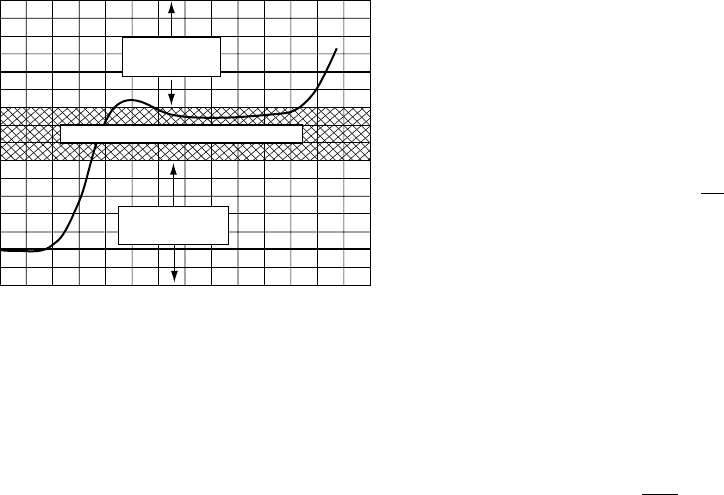Mark James E. (ed.). Physical Properties of Polymers Handbook
Подождите немного. Документ загружается.


apparatus, shown in Fig. 53.1, has been designed to use this
technique.
The asymptotic values for the mass loss rate in combus-
tion and flame heat flux determined from the radiation
scaling technique in the ASTM E 2058 FPA are listed in
Table 53.5. The measured asymptotic values of the mass
loss rate in combustion in large-scale fires reported in the
literature are also listed in Table 53.5. The asymptotic flame
TABLE 53.4. Ignition temperature, thermal conductivity, and specific heats of polymers.
a
Polymers
Ignition
temperature (K)
b
Specific heat
(kJ/kg-K)
Thermal
conductivity
(kW=m-K) 10
4
Natural polymers
Cotton 527 — —
News paper 503 — —
White pine, shavings 533 — —
Nonhalogenated synthetic polymers
ABS 527 1.26–1.67 1.88–3.35
Acetal homopolymer — 1.46 2.30
Acrylics — 1.46 1.67–2.51
Cellulose acetate — 1.26–2.09 1.67–3.35
Epoxy — 1.05 1.67–2.09
Epoxy/silica — 0.84–1.13 4.18–8.37
Nylon 6/6 785 1.67 2.43
Nylon 6/6/33% glass — 1.26 2.13
Nylon 6 — 1.67 2.43
Nylon 6/30–35% glass — 2.09 2.43
Polymethylmethacrylate 651 2.09 2.68
Polyethylene
Low density 622 2.30 3.35
Medium density — 2.30 3.35–4.18
High density — 2.30 4.60–5.19
Polypropylene 736 1.92 1.17
Polystyrene 675 1.34 1.00–1.38
Polycarbonate 651 1.17–1.26 1.92
Polyester — 1.17–2.30 1.76–2.89
Polyester/premix chopped glass — 1.05 4.18–6.69
Polyaryl ether — 1.46 2.98
Polyether sulfone — 1.09 1.34–1.84
Phenol-formaldehyde — 1.59–1.76 1.26–2.51
Polyphenylene oxide — 1.34 1.88
Polyurethane — 1.67–1.88 0.63–3.10
Styrene-acrylonitrile (SAN) — 1.34–1.42 1.21–1.26
Styrene-butadiene (SB) 645 1.88–2.09 1.51
Halogenated synthetic polymers
PVC 675 1.34 1.25–2.93
PVC
2
— 1.34 1.26
PTFE 767 1.05 2.51
FEP 900 1.17 2.51
PVF
2
— 1.38 1.26
PCTFE — 0.92 1.97–2.22
Inert fibers for composite systems
Kevlar — — 2.00
Glass — — 10.5
Quartz — — 17.2
Graphite — — 50.2
Sapphire (aluminum oxide) — — 240
Silicone carbide — — 850
a
Data taken from Refs. 11 and 12.
b
Estimated from the CHF value in Table 53.3.
896 / CHAPTER 53

heat flux values, determined in the ASTM E 2058 FPA are
in good agreement with the values derived from the mass
loss rate in large-scale fires.
The asymptotic flame heat flux values vary from 22 to 77
kW=m
2
, dependent primarily on the pyrolysis mode rather
than on the chemical structures. For examples, for the li-
quids, which vaporize primarily as monomers or as very low
molecular weight oligomer, the asymptotic flame heat flux
values are in the range of 22---44 kW=m
2
, irrespective of
their chemical structures. For polymers, which vaporize as
high molecular weight oligomer, the asymptotic flame heat
flux values increase substantially to the range of 49 to
71 kW=m
2
, irrespective of their chemical structures. The
independence of the asymptotic flame heat value from
the chemical structure is consistent with the dependence of
the flame radiation on optical thickness, soot concentration
and flame temperature.
Decrease in the flame heat flux and increase in the heat of
gasification and surface re-radiation loss through various
passive fire protection techniques would prevent the fire to
grow and propagate beyond the ignition zone and the thermal
and nonthermal hazards would be reduced and/or eliminated.
53.5 FIRE PROPERTIES ASSOCIATED WITH
FLAME PROPAGATION: LIMITING OXYGEN
INDEX AND FIRE PROPAGATION INDEX
Flame propagation is a process where the pyrolysis front
moves beyond the ignition zone over the polymer surface,
TABLE 53.5. Asymptotic mass loss rate and flame heat flux.
Mass loss rate
(kg=m
2
-s) 10
3
Flame heat flux
(kW=m
2
)
Polymers/Liquids
a
Flame rad.
Scaling tech
b
Largescale
Flame rad.
scaling tech
b
Largescale
Aliphatic carbon-hydrogen atoms
Polyethylene 26 — 61 —
Polypropylene 24 — 67 —
Heavy fuel oil (2.6–23 m) — 36
c
—29
Kerosene (30–80 m) — 65
c
—29
Crude oil (6.5–31 m) — 56
c
—44
n-Dodecane (0.94 m) — 36
c
—30
Gasoline (1.5–223 m) — 62
c
—30
JP-4 (1.0–5.3 m) — 67
c
—40
JP-5 (0.60–17 m) — 55
c
—39
n-Heptane (1.2–10 m) 66 75
c
32 37
n-Hexane (0.75–10 m) — 77
c
—37
Transformer fluids (2.37 m) 27–30 25–29 23–25 22–25
Aromatic carbon-hydrogen atoms
Polystyrene (0.93 m) 36 34 75 71
Xylene (1.22 m) — 67
c
—37
Benzene (0.75–6.0 m) — 81
c
—44
Aliphatic carbon-hydrogen-oxygen atoms
Polyoxymethylene 16 — 50 —
Polymethylmethacrylate (2.37 m) 28 30 57 60
Methanol (1.2–2.4 m) 20 25 22 27
Acetone (1.52 m) — 38
c
—24
Aliphatic carbon-hydrogen-oxygen-nitrogen atoms
Expanded Polyurethanes (flexible) 21–27 — 64–76
Expanded Polyurethanes Rigid 22–25 — 49–53 —
Aliphatic carbon-hydrogen-halogen atoms
Polyvinylchloride 16 — 50
TefzelT (ETFE) 14 — 50
TeflonT (FEP) 7 — 52
a
Numbers in parentheses are the pool diameters in meters.
b
Flame radiation scaling technique: pool diameter fixed at 0.10 m, Y
0
$0:30. ASTM E 2058 FPA.
c
Taken from various references in the literature.
FLAMMABILITY / 897

accompanied by the sustained combustion process. The rate
of the movement of the pyrolysis front, accompanied by the
sustained combustion process, is defined as the flame propa-
gation rate. For a sustained fire propagation process, flame
or external heat sources need to transfer heat flux ahead of
the pyrolysis front to satisfy the CHF and TRP values.
Flame propagation can occur in the downward, upward,
and horizontal directions.
Three test apparatuses and methods have been developed
to determine the fire properties associated with flame propa-
gation: (1) the ASTM D 2863 oxygen index test method for
downward flame propagation for small samples [14]; (2) the
ASTM E 1321-90 lateral ignition and flame spread (LIFT)
test method for horizontal and lateral flame propagation
[15,16]; and (3) the fire propagation index (FPI) test method
for vertical flame propagation [2,3,17,18].
In the LIFT and FPI test methods, the following definition
of the flame propagation velocity for thermally thick poly-
mers is utilized [2,3,7,15]:
u ¼
funct(
_
qq
00
f
)
[DT
2
ig
krc
P
]
, (53:6)
where u is the flame propagation rate in m/s, funct (
_
qq
00
r
)isa
function representing the flame heat flux transferred to the
surface of the polymer ahead of the pyrolysis front
(kW
2
=m
3
), r is the density of the polymer (kg=m
3
), c
p
is
the specific heat of the polymer (MJ/kg-K), k is the thermal
conductivity of the polymer (kW/m-K) and D T
ig
is the
ignition temperature above ambient (K) [see the definition
of the TRP for thermally thick polymer in Eq. (53.4)].
53.6 TESTING METHODS FOR FLAME
PROPAGATION
53.6.1 The ASTM D 2863 Oxygen Index Test
In this test, downward flame propagation for small verti-
cal sheets (6.5-mm wide, 70–150-mm long, 3-mm thick) is
examined, in air flowing in the opposite direction with
variable oxygen concentration [14]. Minimum oxygen
concentration (volume percent) at or below which the
downward flame propagation cannot be sustained, defined
as the limiting oxygen index (LOI), is determined [14]. The
LOI values reported in the literature [8,19] are compiled in
Table 53.6.
For PMMA, LOI¼17.3 in Table 53.6 which is higher than
the oxygen concentration of 16.0% required for flame ex-
tinction for larger PMMA slabs [6]. The difference is prob-
ably due to differences in the flame radiation and flow
characteristics. For example, for larger PMMA slabs ex-
posed to external heat flux values of 40, 60, and
65 kW=m
2
in the ASTM E 2058 FPA, flame extinction
occurs at oxygen concentrations of 13.0%, 12.0%, and
11.5%, respectively [6]. The LOI value decreases with in-
crease in the gas temperature as indicated by the LOI values
of the composite systems in Table 53.6.
The oxygen index test utilizes the flame radiation scaling
technique for small samples and indirectly assesses heat flux
from the flame through LOI. At or below the LOI value of a
polymer, the heat flux requirements for CHF and TRP
values for fire propagation are not satisfied. The higher is
the LOI of a polymer, higher are its CHF and TRP values
and/or lower is the heat flux provided by its flame, and the
polymer is considered as fire hardened.
The oxygen index test is used for molded polymers,
fabrics, expanded polymers, thin films, polymers which
form char, drip, or soften, and for liquids. The data are
reproducible. The test is used to study polymer combustion
chemistry, fire retardant treatment of the polymers and for
screening the polymers. No relationships have been estab-
lished between LOI and the flame heat flux, CHF, TRP, and
fire propagation rate. The application of the oxygen index
test data to predict the fire propagation behavior of polymers
expected in actual fires is thus uncertain.
53.6.2 The ASTM E 1321-90 Lateral Ignition
and Flame Spread (LIFT) Test
Equation (53.6) is expressed as [15]:
u ¼
C
TRP
2
, (53:7)
where C is defined as the flame heating parameter
(kW
2
=m
3
). The ignition and flame spread tests are per-
formed in normal air at various external heat flux values
[15,16]. In the ignition tests, 155-155-mm samples are
exposed to various external heat flux values and times to
flame attachment are measured [15,16]. The values of
k, r, c
p
, DT
ig
are determined from the relationship between
the time to flame attachment and external heat flux [15,16].
These values can be used to calculate the TRP value [Eq.
(53.4)].
In the flame spread tests, 155-mm wide and 800-mm long
horizontal samples in a lateral configuration are used
[15,16]. The samples are exposed to an external heat flux
which is 5 kW=m
2
higher than the CHF value in the ignition
zone [15,16]. Beyond the ignition zone, the external heat
flux decreases gradually and is significantly lower than the
CHF value at the end of the sample [15,16]. The sample is
preheated to thermal equilibrium and ignited with a pilot
flame in the ignition zone. The pyrolysis front is tracked as a
function of time and is used to determine the flame heating
parameter and used in Eq. (53.7) along with the TRP value
to calculate the flame propagation rate. The flame propaga-
tion rate calculated from the data reported in Refs. 15 and 19
are listed in Table 53.7. The relative flame propagation rate
is also listed in Table 53.7.
In the LIFT Apparatus, most of the common polymers
and carpets have faster lateral flame propagation than
898 / CHAPTER 53

TABLE 53.6. Limiting oxygen indices for polymers.
a
Polymer LOI Polymer LOI
Cotton 16–17 Polyethylene1 17.4
Cotton (loosely woven) 18.5 Polyethylene2 17.4
Filter paper 18.2 Polyethylene-50% Al
2
O
3
19.6
Wood (birch) 20.5 Polypropylene 17.4
Wood (red oak) 23.0 Polypropylene-30% FG 18.5
Wood (plywood) 23.0 Polystyrene1 17.8
Cellulose 19.0 Polystyrene2 17.6–18.3
Cellulose acetate (dry) 16.8 Polymethylmethacrylate(PlexiglasT) 17.3
Cellulose acetate (4.9% water) 18.1 Polycarbonate1 22.5
Cellulose butyrate (0.06% water) 18.8 Polycarbonate2 24.9
Cellulose butyrate (2.8% water) 19.9 Polycarbonate3 26.0–28.0
Cellulose acetate-butyrate 19.6 ABS-1 18.3–18.8
Rayon 18.7–18.9 ABS-2 18.8
Wool (loosely woven) 23.8 ABS-20% FG 21.6
Wool fiber (dry cleaned) 25.2 SBR foam 16.9
Leather (chrome based) 34.8 Nylon fiber 20.1
Natural rubber foam 17.2 Nylon-6,6 24.3
Polyacetal (CelconT) 14.9 Nylon-6,6 24.0–29.0
Polyacetal-30% FG 15.6 Nylon-6,12 25.0
Polyformaldehyde 15.0 Nylon-6 25.0–26.0
Poly(ethylene oxide) 15.0 Polyacrylonitrile 18.0
Polyoxymethylene (DelrinT) 14.9 Polyimide (KaptonT) 36.5
Polyphenylene oxide 29.9 Silicon rubber 30.0
Polyurethane foam 16.5 Polyester2–70% fiber glass, 8C
Polyvinyl alcohol 22.5 25 28.0
Polysulfone 30.0–32.0 100 28.0
PVC fiber 37.1 200 13.0
PVC (rigid) 45.0–49.0 300 <10
PVC (chlorinated) 45.0–60.0 Polyester3–70% fiber glass, 8C
Poly(vinyl fluoride) (TedlarT) 22.6 25 52.0
Polyethylene (20% chlorine) 24.5 100 95.0
Neoprene 40.0 200 77.0
Neoprene rubber 26.3 300 41.0
Polyisoprene 18.5 Epoxy resin 19.8
Poly(vinylidene chloride) (SaranT) 60.0 Epoxy1–65% fiber glass, 8C
Polytrichlorofluoroethylene 95.0 25 38.0
TeflonT (TFE) 95.0 100 43.0
NomexT 28.5 200 34.0
Polyester fabric 20.6 300 16.0
Polyester 41.5 Epoxy2–65% fiber glass, 8C
Polyester-70% fiber glass; (heated to 8C) 25 50.0
25 23.0 100 59.0
100 23.0 200 49.0
200 <10 300 24.0
300 <10
Epoxy3–65% fiber glass, (heated to 8C) Phenolic-80% fiber glass, 8C
25 43.0 200 94.0
100 54.0 300 80.0
200 47.0 Phenolic-84% Kevlar, 8C
300 27.0 25 28.0
Phenolic resin 21.0 100 30.0
Phenol-formaldehyde resin 35.0 200 29.0
Phenolic-80% fiber glass, (heated to 8C) 300 26.0
25 53.0
100 98.0
a
Data taken from Refs. 8 and 19.
FLAMMABILITY / 899

Douglas fir. Three out of five aircraft panel materials also
have faster lateral flame propagation than a Douglas fir. For
most of the ordinary polymers, the lateral flame propagation
rate is either comparable to or lower than the rate for a
Douglas fir.
53.6.3 The Fire Propagation Index (FPI) Test for
Vertical Flame Propagation
The fire propagation test is performed in the ASTM E 2058
FPA (Fig. 53.1) using the flame radiation scaling tech-
nique with the TRP value determined from the ignition test.
The test can be considered as a larger version of the ASTM D
2863 oxygen index test, with an ignition zone provided by
four external heaters. In the test, upward fire propagation is
examined under co-flowing air with an oxygen concentra-
tion of 40% [2,3]. Polymers as vertical slabs and cylinders of
up to 600 mm in length and up to about 25 mm in thickness,
100 mm in width or diameter are used. The chemical heat
release rate is measured during flame propagation and is used
in the following relationship [modified Eq. (53.6)]:
ffiffiffi
u
p
/
(0:42
_
QQ
0
ch
)
1=3
[DT
ig
(krc
p
)
1=2
]
: (53:8)
where
_
QQ
0
ch
is the chemical heat release rate per unit width or
circumference (kW/m). The fire propagation index (FPI) is
calculated from Eq. (53.8) with a proportionality constant of
1000 kW
2=3
s
1=2
=m
5=3
and TRP from Eq. (53.4):
FPI ¼ 1000
(0:42
_
QQ
0
ch
)
1=3
TRP
: (53:9)
The FPI values determined in this fashion are listed in Table
53.8 for selected polymers and shown in Fig. 53.3 for a fire
TABLE 53.7. Lateral flame propagation rate in the LIFT apparatus.
a
Polymers Thickness (mm)
Flame
propagation
rate (mm/s)
Relative flame
propagation rate
Natural polymers
Hardboard 3 10 1.0
Hardboard (gloss paint) 3 5 0.5
Hardboard 6 6 0.6
Plywood plain 6 11 1.1
Plywood plain 13 13 1.3
Particle board 13 5 0.5
Douglas fir particle board 12 10 1.0
Fiber insulation board — 7 0.7
Gypsum board, wall paper — 3 0.3
Gypsum board 13 10 1.0
Asphalt shingle — 9 0.9
Fiberglass shingle — 10 1.0
Synthetic polymers
Polyisocyanurate foam 51 37 3.7
Rigid polyurethane foam 25 28 2.8
Flexible polyurethane foam 25 16 1.6
Polymethylmethacrylate 2 11 1.1
Polymethylmethacrylate 13 11 1.1
Polycarbonate 2 7 0.7
Carpets
Acrylic — 17 1.7
Nylon/wool blend — 15 1.5
Wool, Untreated — 13 1.3
Wool, Treated — 4 0.4
Aircraft panel materials
Phenolic fiberglass — 14 1.4
Phenolic kevlar — 13 1.3
Epoxy kevlar — 11 1.1
Phenolic graphite — 9 0.9
Epoxy fiberglass — 6 0.6
a
Calculated from the data reported in Refs. 15 and 20.
900 / CHAPTER 53

retarded polypropylene slab. The FPI values show the fol-
lowing flame propagation behavior in large-scale fires:
1. FPI#7: there is no flame propagation beyond the igni-
tion zone, defined as nonpropagating (NP). Polymers
showing this type of behavior are defined as Group 1-NP
polymers. Flame is at a critical extinction condition.
2. 7<FPI<10: there is decelerating flame propagation
beyond the ignition zone, defined as decelerating
TABLE 53.8. Fire propagation index for polymers.
Polymers
Diameter/
thickness (mm) FPI Group
Fire
propagation
a
Synthetic polymers
PMMA 25 30 3 P
PP-FR 25 410 3 P
Polymers as electrical cable insulation and jacket
PVC/PVC (power) 4–13 11–28 2–3 P
PVC/PVC (communications) 4 36 3 P
PE/PVC (power) 11 16–23 3 P
PE/PVC (communications) 4 28 3 P
PVC/PE (power) 34 13 2 P
PVC/PVF (communications) 5 7 1 NP
Silicone/PVC (power) 16 17 2 P
Silicone/XLPO (power) 55 6–8 1 NP; DP
Si/XLPO (communications) 28 8 1 DP
EP/EP (power) 10–25 6–8 1 NP; DP
XLPE/XLPE (power) 10–12 9–17 1–2 DP; P
XLPE/XLPO (communications) 22–23 6–9 1 NP; DP
XLPE/EVA (power) 12–22 8–9 1 DP
XLPE/Neoprene (power) 15 9 1 DP
XLPO/XLPO (power) 16–25 8–9 1 DP
XLPO, PVF/XLPO (power) 14–17 6–8 1 NP; DP
EP/CLP (power) 4–19 8–13 1–2 DP; P
EP, FR/None (power) 4–28 9 1 DP
EP-FR/none (communications) 28 12 2 P
ETFE/EVA (communications) 10 8 1 DP
FEP/FEP (communications) 8–10 4–5 1 NP
Composite systems
Polyester1-70% fiber glass 4.8 13 2 P
Polyester2-70% fiber glass 4.8 10 2 P
19 8 1 DP
45 7 1 NP
Epoxy1-65% fiber glass 4.4 9 1 DP
Epoxy2-65% fiber glass 4.8 11 2 P
Epoxy3-65% fiber glass 4.4 10 2 P
Epoxy4-76% fiber glass 4.4 5 1 NP
Phenolic-80% fiber glass 3.2 3 1 NP
Epoxy-82% fiber glass-phenolic — 2 1 NP
Phenolic-84% kevlar 4.8 8 1 DP
Cyanate-73% graphite 4.4 4 1 NP
PPS-84% fiber glass 4.4 2 1 NP
Epoxy-71% fiber glass 4.4 5 1 NP
Polymers as conveyor belts
b
SBR — 8–11 1–2 DP; P
CR — 5 1 NP
CR/SBR — 8 1 DP
PVC 4–10 1–2 NP; DP
a
P: propagating; DP: decelerating propagation; NP: nonpropagating.
b
3–25 mm thick.
FLAMMABILITY / 901

propagation (DP). Flame propagation beyond the igni-
tion zone is limited. Polymers showing this type of
behavior are defined as Group 1-DP polymers.
3. 10#FPI<20: there is slow flame propagation beyond
the ignition zone. Polymers showing this type of be-
havior are defined as Group 2 polymers.
4. FPI$20: there is a rapid flame propagation beyond the
ignition zone. Polymers showing this type of behavior
are defined as Group 3 polymers.
The FPI is one of the most important fire properties to
assess fire hazard and protection requirements. Increasing
the TRP value and decreasing the heat release rate for
polymers by various passive fire protection techniques
would decrease the FPI value and change the fire propaga-
tion behavior from propagating to decelerating to non-
propagating. Passive fire protection techniques could in-
volve modifications of chemical structures, incorporation
of fire retardants, and changes in the shape, size, and ar-
rangements of the polymers, use of coatings, and inert
barriers. The heat release rate could also be reduced by the
application of active fire protection agents such as water,
Halon and alternates, etc.
53.7 FIRE PROPERTIES ASSOCIATED WITH THE
GENERATION OF PRODUCTS: YIELDS OF
PRODUCTS
The mass generation rate of a product is directly propor-
tional to the mass loss rate, the proportionality constant is
defined as the yield of the product [3,4]:
_
GG
00
j
¼ y
j
_
mm
00
f
, (53:10)
where
_
GG
00
j
is the mass generation rate of product j
(kg=m
2
s) and y
j
is the yield of product j (kg/kg). The
average yield of a product is determined from the ratio of
the total mass of the product generated, W
j
, obtained by the
summation of the mass generation rate of the products to
the total mass of the polymer gasified, W
f
, obtained by the
summation of the mass loss rate:
y
j
¼
W
j
W
f
: (53:11)
The average yields of products obtained in this fashion are
listed in Table 53.9.
53.7.1 Generation Rates of Products at Various Heat
Fluxes
The generation rates of products can be predicted at
various heat flux values from the following relationship
obtained from Eqs. (53.5) and (53.10):
_
GG
00
j
¼
y
j
DH
g
(
_
qq
00
e
þ
_
qq
00
f
_
qq
00
rr
), (53:12)
where y
j
=DH
g
is defined as the product generation param-
eter (PGP) (kg/kJ). PGP values of the products are inde-
pendent of the fire size, but depend on the ventilation and
can be calculated from the data such as listed in Tables 53.2,
53.5, and 53.9, from the slopes of the lines obtained by
plotting the generation rates of the products against the
external heat flux for various fire scenarios with specified
external and flame heat flux values.
53.7.2 Generation of Products and Ventilation
The concentrations of products generated at various ven-
tilation conditions are predicted by the following equations
[21]:
c
j,v
¼ (y
j,1
=S)(r
a
=r
j
)[1 þ{a= exp (bF
j
)}]F, (53:13)
where c
j,v
is the concentration for the ventilation controlled
combustion; y
j,1
=S is the yield of product j per unit mass of
air consumed (kg/kg) for well-ventilated combustion (val-
ues are listed in Table 53.10), r
a
and r
j
are the densities of
air and product j respectively (kg=m
3
)(r
a
=r
j
values for O
2
,
CO, CO
2
, hydrocarbons (methane) and smoke (carbon) are
0.905, 0.654, 1.034, 1.804, and 2.333, respectively); F is the
equivalence ratio (ratio of the amount of gasified polymer
(fuel) to the amount of air, normalized by the stoichiometric
air-to-fuel ratio; for well-ventilated combustion, F<1:0
and for ventilation controlled combustion, F>1:0); a, b,
and j are the ventilation correlation coefficients. Values for
the coefficients for CO, hydrocarbons, and smoke listed in
Table 53.11. For O
2
and CO
2
, the values of the coefficients
are same and are independent of the chemical structures
within the halogenated and nonhalogenated polymers (for
100
0
0
2
4
6
8
10
12
14
16
200 300
Time (second)
Fire Propagation Index
400 500 600 700
Propagating
(Groups 2 & 3)
Decelerating Propagation (Group 1-D)
Non-Propagating
(Group 1 − N)
FIGURE 53.3. Fire propagation index versus time for a
10 mm thick, 100 mm wide, and 600 mm long vertical slab
of fire retarded polypropylene in co-flowing air with 40% oxy-
gen concentration. The sides and back of the slab were
covered tightly with ceramic paper and heavy duty aluminum
foil. The data were measured in the ASTM E 2058 FPA.
902 / CHAPTER 53

TABLE 53.9. Yields of products and heats of combustion for well ventilated combustion.
a
Yield (kg/kg) Heat of Combustion (MJ/kg)
d
Polymers
b
CO
2
CO Hyd
c
Smoke Comp Chem Con Rad
Natural polymers
Tissue paper 1.05 — — — — 11.4 6.7 4.7
News paper 1.32 — — — — 14.4 — —
Wood (red oak) 1.27 0.004 0.001 0.015 17.1 12.4 7.8 4.6
Wood (Douglas fir) 1.31 0.004 0.001 — 16.4 13.0 8.1 4.9
Wood (pine) 1.33 0.005 0.001 — 17.9 12.4 8.7 3.7
Corrugated paper 1.22 — — — — 13.2 — —
Wood (hemlock)
e
1.22 — — 0.015 — 13.3 — —
Wool 100%
e
1.79 — — 0.008 — 19.5 — —
Synthetic polymers
ABS
e
— — — 0.105 — 30.0 — —
POM 1.40 0.001 0.001 — 15.4 14.4 11.2 3.2
PMMA 2.12 0.010 0.001 0.022 25.2 24.2 16.6 7.6
PE 2.76 0.024 0.007 0.060 43.6 38.4 21.8 16.6
PP 2.79 0.024 0.006 0.059 43.4 38.6 22.6 16.0
PS 2.33 0.060 0.014 0.164 39.2 27.0 11.0 16.0
Silicon 0.96 0.021 0.006 0.065 21.7 10.6 7.3 3.3
Polyester-1 1.65 0.070 0.020 0.091 32.5 20.6 10.8 9.8
Polyester-2 1.56 0.080 0.029 0.089 32.5 19.5 — —
Epoxy-1 1.59 0.080 0.030 — 28.8 17.1 8.5 8.6
Epoxy-2 1.16 0.086 0.026 0.098 28.8 12.3 — —
Nylon 2.06 0.038 0.016 0.075 30.8 27.1 16.3 10.8
Polyamide-6
e
2.64 — — 0.011 — 28.8 — —
Silicon 0.96 0.21 0.005 0.078 21.7 10.9 — —
Expanded polyurethanes (flexible)
GM21 1.55 0.010 0.002 0.131 26.2 17.8 8.6 9.2
GM23 1.51 0.031 0.005 0.227 27.2 19.0 10.3 8.7
GM25 1.50 0.028 0.005 0.194 24.6 17.0 7.2 9.8
GM27 1.57 0.042 0.004 0.198 23.2 16.4 7.6 8.8
Expanded polyurethanes (rigid)
GM29 1.52 0.031 0.003 0.130 26.0 16.4 6.8 9.6
GM31 1.53 0.038 0.002 0.125 25.0 15.8 7.1 8.8
GM35 1.58 0.025 0.001 0.104 28.0 17.6 7.8 9.8
GM37 1.63 0.024 0.001 0.113 28.0 17.9 8.7 9.2
GM41 1.18 0.046 0.004 — 26.2 15.7 5.7 10.0
GM43 1.11 0.051 0.004 — 22.2 14.8 6.4 8.4
Expanded polystyrenes
GM47 2.30 0.060 0.014 0.180 38.1 25.9 11.4 14.5
GM49 2.30 0.065 0.016 0.210 38.2 25.6 9.9 15.7
GM51 2.34 0.058 0.013 0.185 35.6 24.6 10.4 14.2
GM53 2.34 0.060 0.015 0.200 37.6 25.9 11.2 14.7
Expanded polyethylenes
1 2.62 0.020 0.004 0.056 41.2 34.4 20.2 14.2
2 2.78 0.026 0.008 0.102 40.8 36.1 20.6 15.5
3 2.60 0.020 0.004 0.076 40.8 33.8 18.2 15.6
4 2.51 0.015 0.005 0.071 40.8 32.6 19.1 13.5
Expanded phenolics
1
e
0.92 — — 0.002 — 10.0 — —
2
e
0.92 — — — — 10.0 — —
Halogenated polymers
PE þ 25% chlorine 1.71 0.042 0.016 0.115 31.6 22.6 10.0 12.6
PE þ 36% chlorine 0.83 0.051 0.017 0.139 26.3 10.6 6.4 4.2
PE þ 48% chlorine 0.59 0.049 0.015 0.134 20.6 7.2 3.9 3.3
FLAMMABILITY / 903

TABLE 53.9. Continued.
Yield (kg/kg) Heat of Combustion (MJ/kg)
d
Polymers
b
CO
2
CO Hyd
c
Smoke Comp Chem Con Rad
PVC 0.46 0.063 0.023 0.172 16.4 5.7 3.1 2.6
PVC-1
e
(LOI ¼ 0.50) 0.64 — — 0.098 — 7.7 — —
PVC-2
e
(LOI ¼ 0.50) 0.69 — — 0.076 — 8.3 — —
PVC
e
(LOI ¼ 0.20) 0.93 — — 0.099 — 11.3 — —
PVC
e
(LOI ¼ 0.25) 0.81 — — 0.078 — 9.8 — —
PVC
e
(LOI ¼ 0.30) 0.85 — — 0.098 — 10.3 — —
PVC
e
(LOI ¼ 0.35) 0.89 — — 0.088 — 10.8 — —
ETFE 0.54 0.060 0.020 0.042 12.6 5.4 — —
PFA 0.37 0.097 — 0.002 5.0 4.7 — —
FEP 0.25 0.116 — 0.003 4.8 4.1 — —
TFE 0.38 0.092 — 0.003 6.2 4.2 — —
Polymers as building products
e
Particle board (PB) 1.28 0.004 — — — 14.0 — —
Fiber board (FB) 1.28 0.015 — — — 14.0 — —
Medium density FB 1.28 0.002 — — — 14.0 — —
Wood panel 1.38 0.002 — — — 15.0 — —
Melamine faced 0.98 0.025 — — — 10.7 — —
Gypsum board (GB) 0.39 0.027 — — — 4.3 — —
Paper on GB 0.49 0.028 — — — 5.6 — —
Plastic on GB 1.31 0.028 — — — 14.3 — —
Textile on GB 1.19 0.025 — — — 13.0 — —
Textile on rock wool 2.29 0.091 — — — 25.0 — —
Paper on PB 1.15 0.003 — — — 12.5 — —
Rigid polyurethane 1.19 0.200 — — — 13.0 — —
Expanded PS 2.60 1.9 0.054 — — 28.0 — —
Composite systems
PEEK-fiber glass
e
1.88 — — 0.042 — 20.5 — —
IPST-fiber glass
e
2.48 — — 0.032 — 27.0 — —
Polyester1-fiber glass
e
2.52 — — 0.049 — 27.5 — —
Polyester2-fiber glass
e
1.47 — — — — 16.0 — —
Polyester3-fiber glass
e
1.18 — — — — 12.9 — —
Polyester4-fiber glass 1.74 — — — — 19.0 — —
Polyester5-fiber glass 1.28 — — — — 13.9 — —
Polyester6-fiber glass 1.47 0.055 0.007 0.070 — 17.9 10.7 7.2
Polyester7-fiber glass 1.24 0.039 0.004 0.054 — 16.0 9.9 6.1
Polyester8-fiber glass 0.71 0.102 0.019 0.068 — 9.3 6.5 2.8
Epoxy1-fiber glass
e
2.52 — — 0.056 — 27.5 — —
Epoxy2-fiber glass 1.10 0.166 — 0.128 — 11.9 — —
Epoxy3-fiber glass 0.92 0.113 — 0.188 — 10.0 — —
Epoxy4-fiber glass 0.94 0.132 — 0.094 — 10.2 — —
Epoxy5-fiber glass 1.71 0.052 — 0.121 — 18.6 — —
Epoxy-fiber glass-paint 0.83 0.114 0.016 0.166 — 11.3 6.2 5.1
Phenolic1-fiber glass 0.98 0.066 0.003 0.023 — 11.9 — —
Phenolic2-fiber glass
e
2.02 — — 0.016 — 22.0 — —
Phenolic-fiber glass-paint 1.49 0.027 0.002 0.059 — 22.9 11.5 11.4
Epoxy-fiberglass-phenolic 1.06 0.134 — 0.089 — 11.5 — —
Vinylester-fiber glass 2.39 — — 0.079 — 26.0 — —
PPS-fiber glass 1.56 0.133 — 0.098 — 17.0 — —
Phenolic-kevlar 1.27 0.025 0.002 0.041 — 14.8 11.1 3.7
Epoxy-kevlar-paint 0.873 0.091 0.016 0.126 — 11.4 6.3 5.1
Phenolic-kevlar-paint 1.67 0.026 0.003 0.062 — 24.6 14.0 10.6
Cyanate-graphite 1.73 0.058 — 0.102 — 18.9 — —
Epoxy-graphite 1.63 0.046 — 0.107 — 17.8 — —
Phenolic-graphite-paint 1.67 0.026 0.003 0.062 — 24.6 14.0 10.6
904 / CHAPTER 53

TABLE 53.9. Continued.
Yield (kg/kg) Heat of Combustion (MJ/kg)
d
Polymers
b
CO
2
CO Hyd
c
Smoke Comp Chem Con Rad
Polymers as electrical cable insulation and jackets
Polyethylene/polyvinylchloride cable
1 2.08 0.100 0.021 0.076 — 31.3 11.6 19.7
2 1.75 0.050 0.013 0.115 — 25.1 11.1 14.0
3 1.67 0.048 0.012 — — 24.0 13.0 11.0
4 1.39 0.166 0.038 — — 22.0 14.0 8.1
5 1.29 0.147 0.042 0.136 — 20.9 10.7 10.2
Polyethylene-polypropylene copolymer/chlorosulfonated polyethylene cable
1 1.95 0.072 0.014 — — 29.6 15.8 13.9
2 1.74 0.076 0.022 — — 26.8 17.0 9.8
3 1.21 0.072 0.014 — — 19.0 12.3 6.7
4 0.99 0.090 0.085 0.082 — 17.4 6.6 10.8
5 0.95 0.122 0.024 — — 17.3 7.5 9.8
6 0.89 0.121 0.022 0.164 — 13.9 9.2 4.7
Silicone/silicone cable
1 1.65 0.011 0.001 — — 25.0 17.5 7.3
2 1.47 0.029 0.001 — — 24.0 20.0 4.0
Crosslinked polyethylene/crosslinked polyethylene cable
1 1.78 0.114 0.029 0.120 — 28.3 12.3 16.0
2 0.83 0.110 0.024 0.120 — 12.5 7.5 5.0
Crosslinked polyethylene/neoprene cable
1 0.68 0.122 0.031 — — 12.6 5.9 6.7
2 0.63 0.082 0.014 0.175 — 10.3 4.9 5.5
Silicone/PVC cable
1 0.76 0.110 0.015 0.111 — 10.0 — —
2 1.19 0.065 0.005 0.119 — 15.6 — —
PVC-nylon/PVC-nylon cable
1 0.63 0.084 0.024 — — 10.2 5.0 5.2
2 0.49 0.082 0.032 0.115 — 9.2 4.8 4.4
Polytetrafluoroethylene/polytetrafluoroethylene cable
1 0.180 0.091 0.012 0.011 — 3.2 2.7 0.4
2 0.383 0.103 — 0.005 — 5.7 — —
Polymers with fiberweb, net-like and multiplex structures
Olefin 1.49 0.006 — — — 16.5 13.3 3.2
PP-1 1.25 0.0029 — — — 14.0 10.8 3.2
PP-2 1.56 0.0048 — — — 17.2 10.5 6.7
Polyester-1 2.21 0.015 — — — 24.6 8.9 15.7
Polyester-2 1.51 0.0079 — — — 16.8 9.1 7.7
Polyester-3 2.55 0.020 — — — 28.5 22.6 5.9
Polyester-4 1.92 0.014 — — — 21.4 12.4 9.0
Rayon-1 1.80 0.043 — — — 20.3 14.1 6.2
Rayon-2 1.91 0.043 0.002 — — 21.5 13.3 8.2
Rayon-3 1.18 0.047 — — — 13.5 8.3 5.2
Polyester-Rayon 1.52 0.005 — — — 16.8 9.1 7.7
Polyester-polyamide 1.82 0.008 — — — 20.2 10.4 9.8
Rayon-PE 1.50 0.027 — — — 16.9 8.72 8.2
a
Data from the ASTM E 2058 FPA (Fig. 53.1). Some of the data are corrected to reflect well-ventilated combustion. All the
data are reported for turbulent fires, i.e., polymers exposed to higher external heat flux values. -: either not measured or are less
than 0.001.
b
Abbreviations are listed in the nomenclature.
c
Hyd: mixture of low molecular weight gaseous hydrocarbons.
d
Comp: net complete heat of combustion; chem: chemical heat of combustion; con: convective heat of combustion; rad:
radiative heat of combustion.
e
Calculated from the data in Refs. 9, 10 and 23.
FLAMMABILITY / 905
